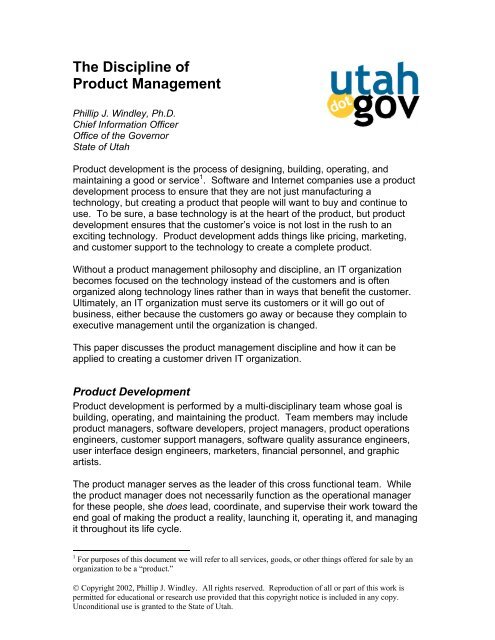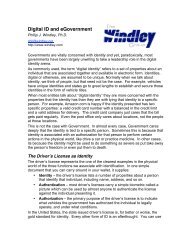The Discipline of Product Management
The Discipline of Product Management
The Discipline of Product Management
Create successful ePaper yourself
Turn your PDF publications into a flip-book with our unique Google optimized e-Paper software.
• Technical support• Billing• Sales callsIn each <strong>of</strong> these events, the company has an opportunity to make a positive ornegative impression on the customer. <strong>The</strong>se periodic contacts are usuallymanaged using some sort <strong>of</strong> Customer Relationship <strong>Management</strong> (CRM)system that tracks all interactions with a customer from all channels. <strong>The</strong> CRMsystem thus allows the product manager (and others) to capture vital informationabout missed sales opportunities, customer complaints, common problems, etc.Using this data the product manager can mold a product so that it better meetscustomer needs and reduces customer support costs.<strong>Product</strong> Upgrade: When a customer is finished using a product, the things canhappen: the customer can be upgraded to a follow on product that meets theirneeds or deprovisioned. <strong>The</strong> product upgrade path is desirable because itkeeps the customer and reduces customer reacquisition costs. Customerfrequently outgrow products or their needs change. If a company has a wellmanaged product portfolio, a product more suited for the customer’s currentsituation will be waiting for them.Deprovisioning: Deprovisioning a customer may seem like an issue that neednot be dealt with: the customer stops using the product and nothing more needbe done. However, in many cases, particularly where service with a recurringbilling has been provided, if the customer is not properly deprovisioned, there willbe future costs resulting from either providing service that is not being paid for orfrom billing a customer who is not receiving service. In either case there arelikely to be costly customer support calls and an unhappy customer. Customerdeprovisioning, where appropriate, should be planned for and built into theproduct from the beginning.<strong>The</strong> <strong>Discipline</strong> <strong>of</strong> <strong>Product</strong> <strong>Management</strong>As a members <strong>of</strong> a discipline, product managers work at all levels <strong>of</strong> a companyin the product development process. For our purposes, we will discuss onlythree levels: product manager, lead product manager, and product strategydirector. Of course, these might have different names and be shared amongmultiple people in any real installation.Role Driver Work <strong>Product</strong><strong>Product</strong> Strategy Business Strategy <strong>Product</strong> PortfolioDirectorLead <strong>Product</strong> Manager <strong>Product</strong> Life Cycle <strong>Product</strong> Roadmap<strong>Product</strong> Manager Customer Life Cycle <strong>Product</strong>
A product strategy director has the following responsibilities:• Define and plan product lines and product enhancements• <strong>Management</strong> <strong>of</strong> product contracts and sales• Strategic direction based on customer needs and business goals• Interpret strategic goals into operational tasks• Make proposals to senior management regarding implications <strong>of</strong> proposedplans• Serves as representative to internal and external clients.• Manages external vendors and deliverables• Takes lead in establishing tactical plans and objectives• Develops and implements administrative and operational matters ensuringachievement <strong>of</strong> objectives• Establishes business plan and operational goals• Evaluates risks and trade-<strong>of</strong>fs; proposes contingency plans<strong>The</strong> product strategy director is accountable in the following areas:• Accountable for overall product direction.• Make key decisions based on risk management and trade-<strong>of</strong>fassessments.• Act as product evangelist• Manage product budget• Anticipate and develop strategies and tactics to meet client businessneeds• Participate in strategic decisions that will have long term impact onproduct success• Provide business leadership to members <strong>of</strong> team including developers,contractors, and others<strong>The</strong> product strategy director is gives leadership in the following ways:• Provide tactical leadership and general direction to managers and teammembers.• Regularly interact with executive management• Handle controversial and sensitive situations with diplomacy• Negotiate with clients and customers as well as executives and otherdirectors• Provide supervisory guidance and mentoring to more junior productmanagers






